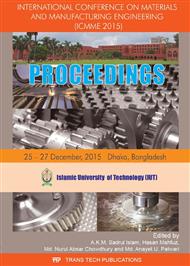[1]
M. Higuchi, A. Yano, A.M.M.S. Ullah, New Design Technologies of Grinding Wheel, Journal of the Japan Society of Grinding Engineers, 42 (1998) 288-291.
Google Scholar
[2]
M.M. Rashid, A.M.M.S. Ullah, J. Tamaki, A. Kubo, Evaluation of Hard Materials using Eco-Attributes, Advanced Materials Research, 325 (2011) 693-698.
DOI: 10.4028/www.scientific.net/amr.325.693
Google Scholar
[3]
Y. Ichida, R. Sato, M. Fujimoto, H. Tanaka, Fractal Analysis of Grain Cutting Edge Wear in Superabrasive Grinding, Journal of Advanced Mechanical Design, Systems, and Manufacturing, 2 (2008) 640-650.
DOI: 10.1299/jamdsm.2.640
Google Scholar
[4]
M. Higuchi, A. Yano, N. Yamamoto, T. Yamaguchi, S. Simomachi, Fractal Characteristics of Grinding Wheel Surface, Journal of the Japan Society for Precision Engineering, 62 (1996) 979-983.
DOI: 10.2493/jjspe.62.979
Google Scholar
[5]
A.M.M.S. Ullah, K. Harib, Simulation of cutting force using nonstationary Gaussian process, Journal of Intelligent Manufacturing, 21 (2010) 681-691.
DOI: 10.1007/s10845-009-0245-2
Google Scholar
[6]
A.M.M. Sharif Ullah, J. Tamaki, A. Kubo, Modeling and simulation of 3D surface finish of grinding, Advanced Materials Research, 126-128 (2010) 672-677.
DOI: 10.4028/www.scientific.net/amr.126-128.672
Google Scholar
[7]
S. Matsui, J. Tamaki, Influence of Elastic and Plastic Behaviors at the Grain Cutting Edge-Workpiece Contact Zone on Grinding Mechanism, Journal of the Japan Society of Precision Engineering, 46 (1980) 177-183.
Google Scholar
[8]
S. Matsui, Statistical Approach to Grinding Mechanism : Theoretical Analysis in the Case where the Value of υ/V is not negligible as compared with the Value 1, Journal of the Japan Society of Precision Engineering, 46 (1980) 298-304.
Google Scholar
[9]
X. Kang, J. Tamaki, A. Kubo, Y. Machida, K. Tanaka, Effect of cutting edge truncation on the grinding mechanism: Theoretical analysis and the experimental investigation, Journal of the Japan Society for Abrasive Technology, 51 (2007) 296-301.
Google Scholar
[10]
P. Stępień, Deterministic and stochastic components of regular surface texture generated by a special grinding process, Wear, 271 (2011) 514-518.
DOI: 10.1016/j.wear.2010.03.027
Google Scholar
[11]
K. Shimada, P.J. Liew, T. Zhou, J. Yan, T. Kuriyagawa, Statistical Approach Optimizing Slant Feed Grinding, Journal of Advanced Mechanical Design, Systems, and Manufacturing, 6 (2012) 898-907.
DOI: 10.1299/jamdsm.6.898
Google Scholar
[12]
M.A.K. Chowdhury, A. Kubo, J. Tamaki, A.M.M.S. Ullah, Computer-aided Simulation of Rotary Diamond Dressing Based on Kinematic Analysis, Journal of Advanced Mechanical Design, Systems, and Manufacturing, 7 (2013) 506-520.
DOI: 10.1299/jamdsm.7.506
Google Scholar
[13]
J. Jiang, P. Ge, J. Hong, Study on micro-interacting mechanism modeling in grinding process and ground surface roughness prediction, The International Journal of Advanced Manufacturing Technology, 67 (2013) 1035-1052.
DOI: 10.1007/s00170-012-4546-9
Google Scholar
[14]
J. Tamaki, A. Kubo, A.M.M.S. Ullah, Wear Characteristics of Nano-polycrystalline Diamond Tool in Cutting of Tungsten Carbide, International Journal of Mechatronics and Manufacturing Systems, 7 (2014) 227-245.
DOI: 10.1504/ijmms.2014.067155
Google Scholar
[15]
A.M.M.S. Ullah, M. Shamsuzzaman, Fuzzy Monte Carlo Simulation using Point-Cloud Based Probability-Possibility Transformation, Simulation, 89(2013) 860-875.
DOI: 10.1177/0037549713482174
Google Scholar


